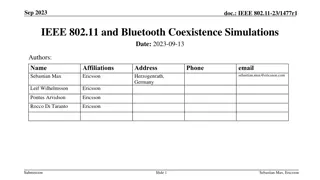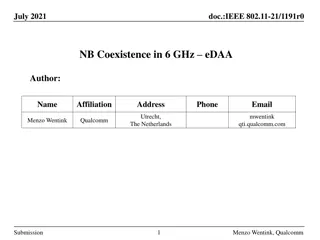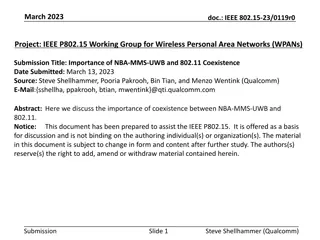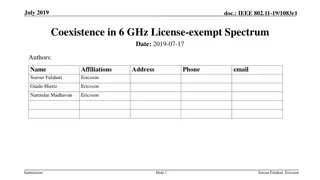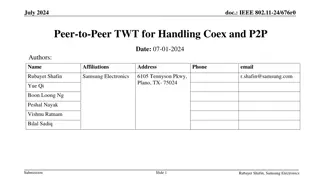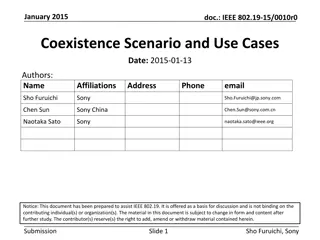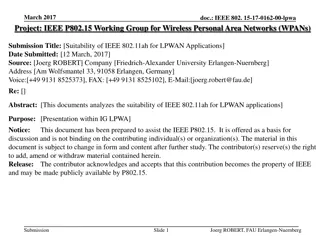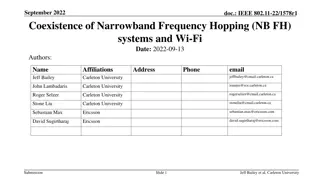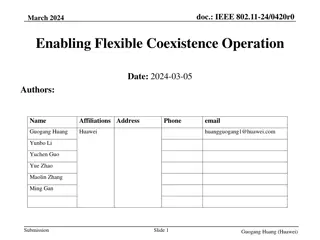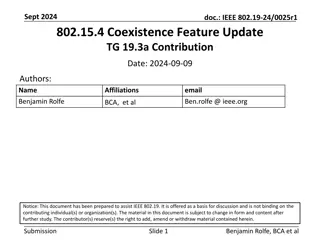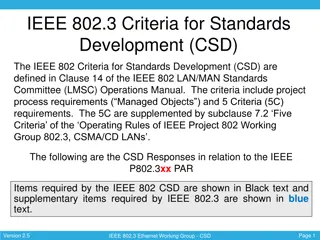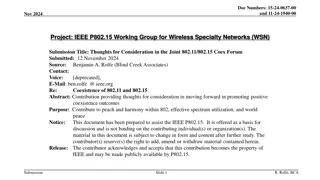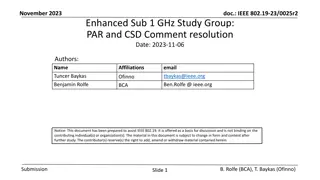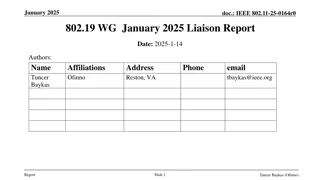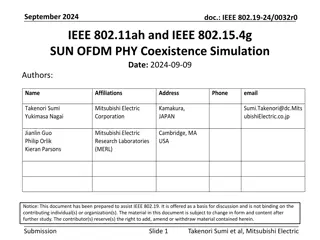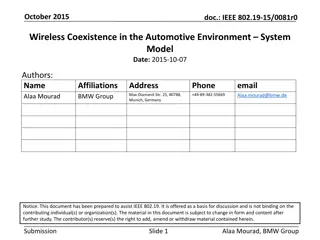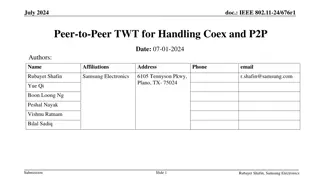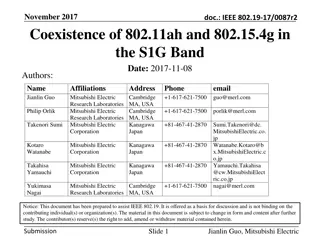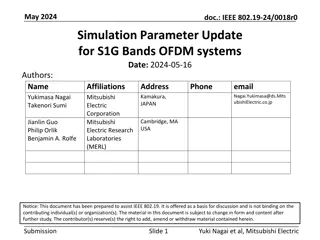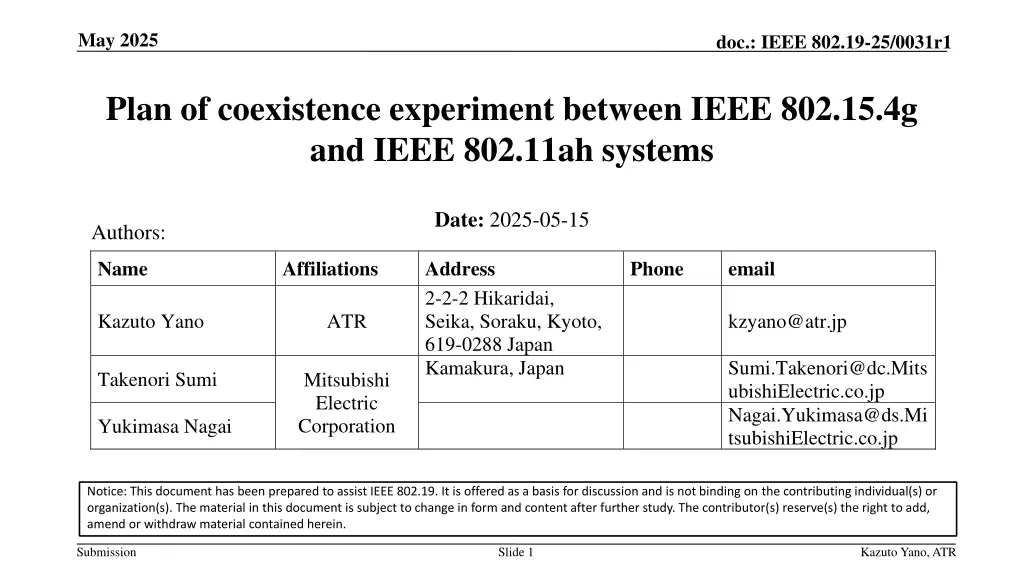
IEEE 802.19-25 Coexistence Experiment Plan
Explore the detailed plan for conducting coexistence experiments between IEEE 802.15.4g and IEEE 802.11ah systems to understand performance impacts and trends. The experiment includes simulation results, layout plans, and configurations to be evaluated for UDP traffic performance metrics. This document outlines the approach to confirm simulation findings through real-world experiments in different conditions, focusing on packet delivery rate and average latency.
Download Presentation

Please find below an Image/Link to download the presentation.
The content on the website is provided AS IS for your information and personal use only. It may not be sold, licensed, or shared on other websites without obtaining consent from the author. If you encounter any issues during the download, it is possible that the publisher has removed the file from their server.
You are allowed to download the files provided on this website for personal or commercial use, subject to the condition that they are used lawfully. All files are the property of their respective owners.
The content on the website is provided AS IS for your information and personal use only. It may not be sold, licensed, or shared on other websites without obtaining consent from the author.
E N D
Presentation Transcript
May 2025 doc.: IEEE 802.19-25/0031r1 Plan of coexistence experiment between IEEE 802.15.4g and IEEE 802.11ah systems Date: 2025-05-15 Authors: Name Affiliations Address 2-2-2 Hikaridai, Seika, Soraku, Kyoto, 619-0288 Japan Kamakura, Japan Phone email Kazuto Yano ATR kzyano@atr.jp Sumi.Takenori@dc.Mits ubishiElectric.co.jp Nagai.Yukimasa@ds.Mi tsubishiElectric.co.jp Takenori Sumi Mitsubishi Electric Corporation Yukimasa Nagai Notice: This document has been prepared to assist IEEE 802.19. It is offered as a basis for discussion and is not binding on the contributing individual(s) or organization(s). The material in this document is subject to change in form and content after further study. The contributor(s) reserve(s) the right to add, amend or withdraw material contained herein. Submission Slide 1 Kazuto Yano, ATR
May 2025 doc.: IEEE 802.19-25/0031r1 Introduction To confirm what happens when IEEE 802.11ah and IEEE 802.15.4g SUN PHYs coexist, some simulation has been conducted [1]. In addition, an initial coexistence experiment between IEEE 802.11ah and IEEE 802.15.4g systems has been conducted [2]. Through this experiment, it was confirmed that IEEE 802.11ah communications can cause performance degradation of IEEE 802.15.4g communications. This contribution shows further experimental plan to support the simulation results in several conditions for developing IEEE 802.19.3a Recommended Practice. Submission Slide 2 Kazuto Yano, ATR
May 2025 doc.: IEEE 802.19-25/0031r1 Example of simulation results in [1] Packet delivery rate and latency are evaluated with different offered load of IEEE 802.15.4g and/or IEEE 802.11ah systems. Submission Slide 3 Kazuto Yano, ATR
May 2025 doc.: IEEE 802.19-25/0031r1 Plan for new experiment To confirmed the performance trends observed through the simulations, we plan to conduct further experiment in an anechoic chamber with different configurations of IEEE 802.15.4g and IEEE 802.11 systems. Performance metric: The following performance of UDP traffic. Packet delivery rate Average latency Submission Slide 4 Kazuto Yano, ATR
May 2025 doc.: IEEE 802.19-25/0031r1 Layout plan for experiment We plan to conduct further experiment in an anechoic chamber. A layout plan of IEEE 802.15.4g and IEEE 802.11ah systems are shown below. One PANC/AP and two NODEs/STAs are employed for each system. IEEE 802.15.4g PANC IEEE 802.11ah AP 5 m 5 m 5 m IEEE 802.15.4g NODE IEEE 802.11ah STA 1.5 m 1.5 m Submission Slide 5 Kazuto Yano, ATR
May 2025 doc.: IEEE 802.19-25/0031r1 Combinations of PHY and MAC configurations to be evaluated Two types of PHY (FSK PHY and OFDM PHY) are listed as possible PHY configurations for IEEE 802.15.4g in [3]. Two types of channel access mechanism (normal CSMA/CA and suspendable- CSMA/CA) have been evaluated through simulations [4]. Two bandwidth (1 MHz and 4 MHz) are listed as possible PHY configurations for IEEE 802.11ah in [3]. In the simulations in [1], Nss = 1 and MCS 0 were assumed. Submission Slide 6 Kazuto Yano, ATR
May 2025 doc.: IEEE 802.19-25/0031r1 Combinations of PHY and MAC configurations to be evaluated (cont.) Therefore, we should conduct experiment with the combinations of PHY/MAC features in the table shown below. We plan to conduct experiments for the combinations indicated by X . (The other combination depends on the availability of devices.) PHY/MAC features of IEEE 802.15.4g PHY of IEEE 802.15.4g IEEE 802.15.4g Normal CSMA/CA Suspendable-CSMA/CA Normal CSMA/CA Suspendable-CSMA/CA Bandwidth of IEEE 802.11ah Channel access mechanism of 1 MHz 4 MHz X X X X X X FSK-PHY OFDM-PHY If devices are available. If devices are available. Submission Slide 7 Kazuto Yano, ATR
May 2025 doc.: IEEE 802.19-25/0031r1 PHY Parameters for experimental evaluation In the conducted simulations, following PHY configurations MCSs for IEEE 802.15.4g PHY are used [1]. IEEE 802.15.4g PHY MCS 2-FSK (400 kHz) Option 3 (400 kHz): OFDM MCS 4 Option 3 (400 kHz): OFDM MCS 5 IEEE 802.15.4g PHY MCS: MCS 0 Transmission power: 13 dBm We plan to use the same MCS configurations in the new experimental evaluation. Transmission power will be set to the minimum level of used equipment due to the difference of the size of the evaluation area between in the simulation and experiment. Submission Slide 8 Kazuto Yano, ATR
May 2025 doc.: IEEE 802.19-25/0031r1 Plan of channel configurations A plan of channel configurations for IEEE 802.15.4g and IEEE 802.11ah systems are shown below. The frequency channel of IEEE 802.15.4g will be set to overlap the spectra of IEEE 802.15.4g and IEEE 802.11ah each other. For 4 MHz IEEE 802.11ah For 1 MHz IEEE 802.11ah IEEE 802.15.4g (Center: 924.6 MHz)) IEEE 802.15.4g (Center: 924.1 MHz)) IEEE 802.11ah (Center: 924.5 MHz) IEEE 802.11ah (Center: 924.0 MHz) Freq. Freq. Submission Slide 9 Kazuto Yano, ATR
May 2025 doc.: IEEE 802.19-25/0031r1 Parameters of IEEE 802.15.4g MAC for experimental evaluation In the simulations in [1], following MAC parameters for IEEE 802.15.4g MAC are evaluated. We plan to use the same configurations in the new experiment. macMinBe: 3 macMaxBe: 5 BE: [macMinBe, macMaxBe] RetryLimit: 4 RetryLimit was set to 20 in the initial experiment [2]. In the new experiment, we will set to the same value in [1] to comply with the simulations. Backoffs: 4 CW: 1 Submission Slide 10 Kazuto Yano, ATR
May 2025 doc.: IEEE 802.19-25/0031r1 Parameters of IEEE 802.11ah MAC for experimental evaluation In the simulations, following parameters for IEEE 802.11ah MAC are evaluated through the simulations [1]. We plan to use the same configurations in the new experiment. CWmin: 15 CWmax: 1023 CW: [CWmin, CWmax] RetryLimit: 7 Submission Slide 11 Kazuto Yano, ATR
May 2025 doc.: IEEE 802.19-25/0031r1 Parameters of data traffic for experimental evaluation Simulation parameters of data traffic used in [1] are as follows. Total offered load: IEEE 802.15.4g-FSK PHY : {10, 20, 40} kb/s IEEE 802.15.4g-OFDM PHY : [20 100] kb/s IEEE 802.11ah (1 MHz bandwidth) : [20 120] kb/s IEEE 802.11ah (4 MHz bandwidth) : [80 480] kb/s Packet size: 100 Bytes We plan to use similar configurations in the new experiment. Total offered load: IEEE 802.15.4g: [10 40] kb/s (both for FSK PHY and OFDM PHY) IEEE 802.11ah: [10 120] kb/s (for 1 MHz), [40 480] kb/s (for 4 MHz) Packet size: 100 Bytes, 200 Bytes (200 Bytes are added to confirm the trend of the simulation results described in the IEEE 802.19.3 Recommended Practice.) Slide 12 Submission Kazuto Yano, ATR
May 2025 doc.: IEEE 802.19-25/0031r1 Summary We plan to conduct to further experimental evaluation of the impact of the coexistence of IEEE 802.15.4g and IEEE 802.11ah systems on the communication performances of these systems. This contribution showed the planned PHY/MAC configurations of both systems, node layout and traffic configurations for the new experiment. Submission Slide 13 Kazuto Yano, ATR
May 2025 doc.: IEEE 802.19-25/0031r1 Reference [1] doc. IEEE 802.19-25/0018r1 [2] doc. IEEE 802.19-25/0019r0 [3] doc. IEEE 802.19-24/0018r0 [4] doc. IEEE 802.19-25/0006r0 Submission Slide 14 Kazuto Yano, ATR

